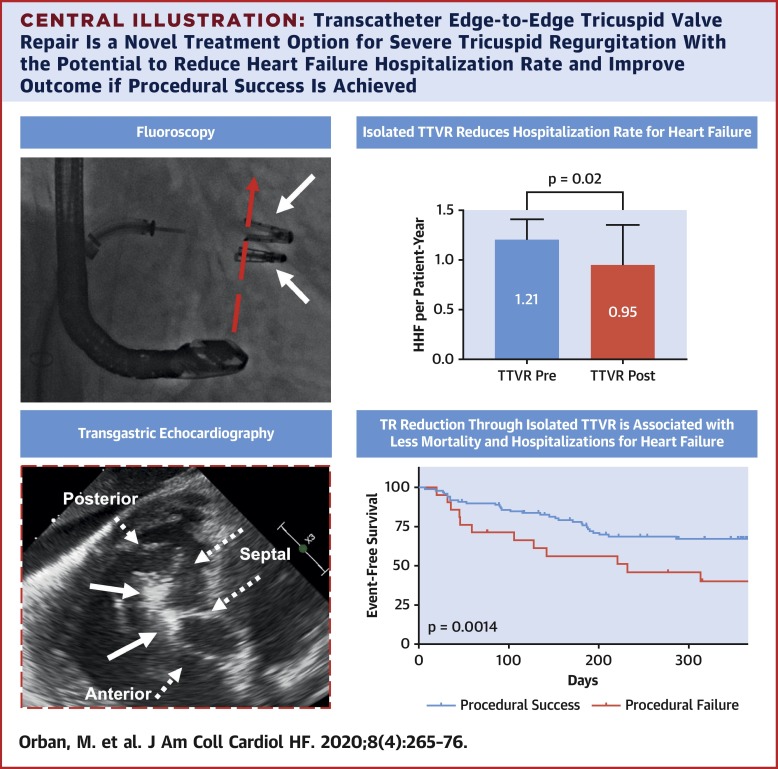JACC: Heart Failure ( IF 13.0 ) Pub Date : 2020-03-30 , DOI: 10.1016/j.jchf.2019.12.006 Mathias Orban 1 , Karl-Philipp Rommel 2 , Edwin C Ho 3 , Matthias Unterhuber 2 , Alberto Pozzoli 4 , Kim A Connelly 5 , Simon Deseive 1 , Christian Besler 2 , Geraldine Ong 5 , Daniel Braun 6 , Jeremy Edwards 5 , Mizuki Miura 4 , Gökhan Gülmez 4 , Lukas Stolz 6 , Mara Gavazzoni 4 , Michel Zuber 7 , Martin Orban 1 , Michael Nabauer 6 , Francesco Maisano 4 , Holger Thiele 2 , Steffen Massberg 1 , Maurizio Taramasso 4 , Neil P Fam 5 , Philipp Lurz 2 , Jörg Hausleiter 1

|
Objectives
The goal of this study was to evaluate the effect of transcatheter edge-to-edge tricuspid valve repair (TTVR) for severe tricuspid regurgitation (TR) on hospitalization for heart failure (HHF) and HF-related endpoints.
Background
Patients with severe TR need effective therapies beyond conservative treatment. The impact of TTVR on HHF and HF-related endpoints is unknown.
Methods
Isolated TTVR was performed in 119 patients. Assessments were conducted of New York Heart Association functional class, 6-min walk distance, Minnesota Living with Heart Failure Questionnaire scores, N-terminal pro–B-type natriuretic peptide level, and medication. HHFs were analyzed in the preceding 12 months before and until the longest available follow-up after TTVR. Results were compared with those of 114 patients who underwent combined mitral and tricuspid valve repair.
Results
Procedural success with a reduction to moderate or less TR and no in-hospital death was achieved in 82% of patients. With a median follow-up of 360 days (interquartile range: 187 to 408 days), a durable TR reduction to moderate or less was achieved in 72% of patients (p < 0.001). TTVR reduced the annual rate of HHF by 22% (1.21 to 0.95 HHF/patient-year; p = 0.02), with concomitant clinical improvement in New York Heart Association functional class (patients in class II or lower: 9% to 67%; p < 0.001), 6-min walk distance (+39 m; p = 0.001), and Minnesota Living with Heart Failure Questionnaire score (−6 points; p = 0.02). N-terminal pro–B-type natriuretic peptide level decreased numerically by 783 pg/ml. Diuretic dose before TTVR was increased, but HF medication did not change after TTVR. Procedural success was associated with improved 1-year survival (79% vs. 60%; p = 0.04) and event-free-survival (death + first HHF: 67% vs. 40%; p = 0.001). Transcatheter mitral and tricuspid valve repair–treated patients had comparable outcomes.
Conclusions
TTVR for severe TR is associated with a reduction of HHF and improved clinical outcomes.
中文翻译:

经导管边缘到边缘的三尖瓣修复可解决严重的三尖瓣关闭不全,减少因心力衰竭而住院。
目标
这项研究的目的是评估经导管的边缘对边缘三尖瓣修复(TTVR)对严重三尖瓣关闭不全(TR)的影响,以治疗心衰(HHF)和HF相关终点。
背景
患有严重TR的患者除了保守治疗外还需要有效的治疗方法。TTVR对HHF和HF相关终点的影响尚不清楚。
方法
119例患者进行了孤立的TTVR。对纽约心脏协会功能性课程,步行6分钟的步行路程,明尼苏达州心衰患者问卷调查得分,N端前B型利尿钠肽水平和药物进行了评估。在TTVR之前和之前的12个月内,对HHF进行了分析,直到进行最长的随访。将结果与114例二尖瓣和三尖瓣联合修补术的患者进行比较。
结果
在82%的患者中,将TR降低至中度或更低或无院内死亡的方法获得了成功。中位随访360天(四分位间距:187至408天),在72%的患者中将TR持久降低至中度或更低(p <0.001)。TTVR将HHF的年率降低了22%(每患者年1.21至0.95 HHF; p = 0.02),同时伴随着纽约心脏协会功能级别的临床改善(II级或更低级别的患者:9%至67%; p <0.001),6分钟步行距离(+39 m; p = 0.001)和明尼苏达州心衰患者问卷调查得分(-6分; p = 0.02)。N端前B型利尿钠肽水平从数值上降低783 pg / ml。TTVR前利尿剂剂量增加,但TTVR后HF药物未改变。手术成功与改善的1年生存率(79%比60%; p = 0.04)和无事件生存率(死亡+首次HHF:67%vs. 40%; p = 0.001)相关。经导管二尖瓣和三尖瓣修复治疗的患者预后相似。
结论
TTVR用于严重TR与减少HHF和改善临床结局有关。



























 京公网安备 11010802027423号
京公网安备 11010802027423号